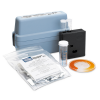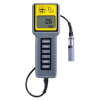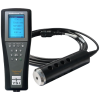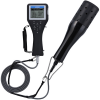You may be asking yourself, what equipment do I need for water quality measurement?
Given the wide array of equipment and parameters available for water quality measurement, there are many questions to consider when planning one of these events. This application guide is intended to help our customers determine what equipment and supplies best suit their application. If you have any questions or wish to order equipment, please contact us at (888)274-8929. Any feedback about this guide is also appreciated!
Some important questions to ask yourself when you are planning your water quality measurement event:
- What water quality parameters do you need to monitor and what is the most cost effective piece of equipment to measure them?
- pH, Conductivity, ORP, Dissolved Oxygen, Turbidity, Temperature, Salinity, Total Dissolved Solids, Depth, etc.
- Are you measuring the water quality down in a well or at the surface?
- If in a well, what length cable on the water quality instrument do you need?
- If doing low flow sampling, does the equipment have a flow-through cell?
When selecting water quality instruments, the sampling method must be considered. See our Water Sampling Applications Page for more information. If you plan to pump a sample to the surface, make sure you have a sample container that is large enough for the probes of the instrument to be fully submerged to take a reading. If you plan on lowering the water quality instrument down into the well, make sure the well casing diameter is large enough to fit the probes of the water quality instrument. Also, it is important to make sure that the instrument has a long enough cable to reach the desired depth you wish to measure at. It is important to note that water quality instruments should not be used in extremely contaminated wells as this could damage the equipment.
Low Flow Sampling
When doing low flow sampling, the use of a flow-through cell is often necessary. A flow-through cell is a chamber that that the water quality instrument's probes fit into that has an inlet for water to be pumped into and an outlet for it to discharge. The water quality instrument is constantly being exposed to a fresh sample from the well, allowing for stabilization of the measured parameters and a good representation of the water quality within the well. Examples of water quality instruments with flow-through cell capability are the YSI Professional Plus, Horiba U-52 and Horiba U-22. All of these instruments measure multiple parameters, see the links for each instrument for more information.
Multi-Parameter Water Quality Instruments
Enviro-Equipment rents many different water quality instruments that measure various water quality parameters. These parameters include but are not limited to pH, Conductivity, ORP, Dissolved Oxygen, Turbidity, Temperature, Salinity, Total Dissolved Solids, Depth, etc. To see a list of instruments, what they measure, and their rental rates please refer to our Water Quality Instrument Rental Page or call us at (888)274-8929 to talk to one of our technicians.
Slug & Pump Aquifer Testing Equipment
Slug Tests and Pump tests are used to calculate aquifer characteristics such as hydraulic conductivity, storativity, transmissivity, etc. In a slug test, a pressure transducer is inserted into the well to measure the changes in the water level elevation. An object known as a Slug that is capable of displacing a recognizable amount of water is dropped into the well to raise the water level elevation. The pressure transducer records the change in water elevation due to the change in pressure within the well. The water level will begin to equillibrate as water flows back into the aquifer. The pressure transducer will log the amount of time this takes and the rate at which it happens, creating a data curve. The same concept can be applied once the slug is removed and the water must flow back into the well due to drawdown. Pump tests are similar to slug tests but involve multiple wells, including pumping wells and monitoring wells. Pumping creates drawdown within the aquifer that can be measured by the pressure transducers in the monitoring wells.
The equipment needed for a slug test or pump test includes a pressure transducer such as the In-Situ LevelTROLL 700, the cable that connects to the pressure transducer, a slug or pump to displace the water, a computer, and the Win-Situ 5 software (included in rentals). A pocket PC called the In-Situ Rugged Reader can also be used to start/stop each test run and view the data without carrying a laptop into the field. Data can be transferred to a computer straight from the LevelTROLL 700 or from the Rugged Reader. Pressure Transducers are rated based on the depth that they are going to be placed within the well. Enviro-Equipment rents 30 PSI and 100 PSI pressure transducers. Make sure the transducer is never exposed to pressure greater than it is rated for. 30 PSI is equal to 69.2 feet of water column, and 100 PSI is equal to 230.6 feet of water column. It is also important to make sure that you have a long enough cable to reach the desired depth. There are also vented and non-vented models of pressure transducers. Vented transducers are for applications where the transducer will be exposed to the atmosphere (non-capped well). Non-vented transducers are for applications where the well will be capped and the transducer will not be exposed to the atmosphere.









